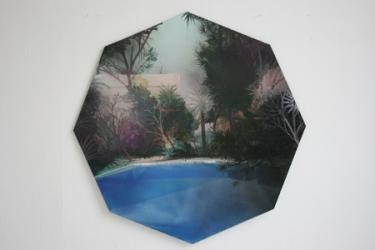Alexander Ernst Voigt
02 May - 06 Jun 2009
ALEXANDER ERNST VOIGT
The surface of the canvas is composed of different parts: abstract scenes contrasted with images of interiors. Across a wall made up of abstractions appears a minimalist interior, austere and modern. The wallpaper at the back of the space repeats the abstraction and appears to project forwards out of the painting, in spite of the imperative of perspective. Another painting shows a view of a garden. It contains a luxuriant, organic proliferation of trees and shrubs. A high white fence glimmers behind the plant life, but is of an entirely different order. Similarly, the swimming pool slowly transmutes into abstract blue shapes that contrast sharply with the garden’s spaciousness. The abstraction in the paintings varies from abrupt to more naturalistic and assumes different forms. It may cover an entire surface − a wall consisting of a forest of white lines or other geometrical shapes − or it may be part of the image: a palm that reveals itself to be just a few lines, or a flight of steps that turns out to be simple blocks of colour. The desolation of these images, the absence of human figures, enables figurative elements to merge with abstractions.
The different sections of which the paintings are composed immediately attract the viewer’s attention. Some emphasise the flat surface of the canvas and are close to the viewer, abstractions serving as repoussoir, determining the position from which the work is viewed and emphasising the here and now of the image. Other sections depict recognisable spaces and objects. These are far away, interiors in space. The painting serves as a window to another world. Alexander Ernst Voigt (Berlin, 1981) playfully combines the classical window with its view of reality and the emphasis in modern painting on the painting’s flat surface. His harmonious juxtaposition of these constructions reveals the interaction between reality and image, mirror and window.
The surface of the canvas is composed of different parts: abstract scenes contrasted with images of interiors. Across a wall made up of abstractions appears a minimalist interior, austere and modern. The wallpaper at the back of the space repeats the abstraction and appears to project forwards out of the painting, in spite of the imperative of perspective. Another painting shows a view of a garden. It contains a luxuriant, organic proliferation of trees and shrubs. A high white fence glimmers behind the plant life, but is of an entirely different order. Similarly, the swimming pool slowly transmutes into abstract blue shapes that contrast sharply with the garden’s spaciousness. The abstraction in the paintings varies from abrupt to more naturalistic and assumes different forms. It may cover an entire surface − a wall consisting of a forest of white lines or other geometrical shapes − or it may be part of the image: a palm that reveals itself to be just a few lines, or a flight of steps that turns out to be simple blocks of colour. The desolation of these images, the absence of human figures, enables figurative elements to merge with abstractions.
The different sections of which the paintings are composed immediately attract the viewer’s attention. Some emphasise the flat surface of the canvas and are close to the viewer, abstractions serving as repoussoir, determining the position from which the work is viewed and emphasising the here and now of the image. Other sections depict recognisable spaces and objects. These are far away, interiors in space. The painting serves as a window to another world. Alexander Ernst Voigt (Berlin, 1981) playfully combines the classical window with its view of reality and the emphasis in modern painting on the painting’s flat surface. His harmonious juxtaposition of these constructions reveals the interaction between reality and image, mirror and window.

